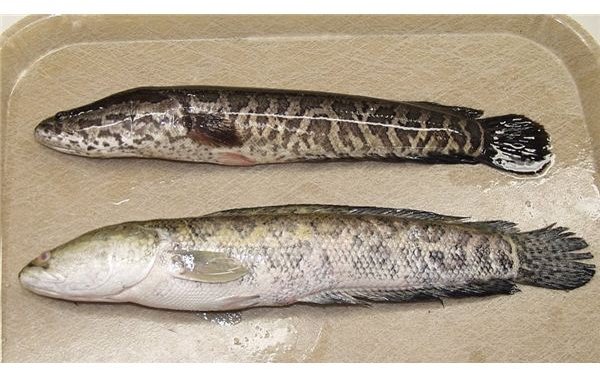The Killer Snakehead Fish: Facts and Information Regarding this Mysterious Creature
Origins
The Northern snakehead fish, also known as the killer snakehead, is an invasive animal in the United States. Originally from China, the killer snakehead was found in an established population in Maryland in 2002, likely released by humans in error. Currently they have breeding populations in many states including Florida, Maryland, Massachusetts, Virginia and Rhode Island as well as sightings in many other states.
Here are some more killer snakehead fish facts that you may find interesting.
Description and Habitat
The killer snakehead can reach a maximum length of approximately 33 inches when full grown and are generally tan in appearance with dark brown mottled patches. A pointed head reminiscent of a snake is what gives this unusual fish its name.
With a need to breath oxygenated air, the killer snakehead fish can and does live outside of water for between 3 and 4 days–as long as they are wet. They can also travel as far as a quarter mile between bodies of water when juveniles, using their fins to propel themselves. This makes them a formidable opponent as an invasive species since they are difficult to contain.
Behavior and Diet
Exclusively a freshwater species, the killer snakehead makes its home in lakes and slow moving streams with a salinity of no more than 10 parts per thousand. The fish can hibernate in cracks during cold weather and can also survive drought weather by burrowing into muddy banks of the streams and lakes it calls home. As mentioned above, the snakehead needs to breathe air and uses a special lung for that purpose which means they can easily survive outside of water, and as young fish can travel between bodies of water.
As a top level predator, the killer snakehead typically feeds on other fish as well as frogs and other small aquatic wildlife. They are not known to be dangerous to humans or pets.
Ecological Impacts
One of the most significant killer snakehead fish facts is that it is considered an aggressive invasive species in areas outside of its native China. First found in the United States in Crofton, Maryland, the fish have used their ability to travel on land between bodies of water to spread extensively.
As top level predators in the US, the killer snakehead can cause major problems in ecosystems. Additionally, they reach maturity within three years and reproduce quickly which is an additional burden on ecosystems that the snakehead invades.
Young snakehead feed on plankton in the water and then fingerling fish while adults feed on other juvenile fish species. Because of this, the killer snakehead fish can completely decimate populations of other fish, which can affect local fisheries.
One of the biggest fears with the killer snakehead in the United States is that they might invade the Great Lakes ecosystem. As 20% of the worlds freshwater, the Great Lakes are very important ecologically and are already under stress from over 180 aquatic invasive species. It is thought that the killer snakehead could cause major issues if introduced. An individual snakehead was found in Lake Michigan off the coast of Chicago in 2004, but there have been no further sightings since that time and it appears to have been an isolated incident.
References and Further Reading
- Virginia Department of Game and Inland Fisheries: Snakeheads and Native Fishes, Do you know the difference?, Snakehead FAQ
- The Baltimore Sun, Potomac Snakeheads not related to others
- Maryland Department of Natural Resources, Northern Snakehead Fish
- USDA Invasive Species Profiles, Northern Snakehead
- USGS, Northern Snakehead Distribution
For additional information on the presence of the killer snakehead fish in your state, contact your states DNR.
Photo Credit: https://fl.biology.usgs.gov/pics/snakehead/snakehead/snakehead_0.html
